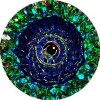So you want something almost like a powerpoint?
Well I would do it like this:
1) Wrap the monitor using peripheral.wrap([side]). This returns an object which you can use to perform monitor actions. For example:
local monitor = peripheral.wrap("left")
monitor.clear()
monitor.setCursorPos(1,1)
monitor.write("Hello!")
The next thing you'll want to do is get an table of all the messages you'd like to display. If you're not familiar with tables, here's an example:
local myDisplayStuff = {
[1] = "Welcome to [x]! We hope you enjoy your stay, and please - abide by the rules.";
[2] = "TODO - Finish the outer wall.";
[3] = "TODO - Rebuilld the giant stadium.";
}
Finally, you'll want to get some code that displays that text in a way that looks good. You could go about this in several ways. The easiest one would be to simply center it on the screen. However, the issue with that is that on occasion you will have text that is too long to center and it will bleed off the screen. If you encounter such a case, you'll have to check each item and wrap it to the next line.
If you want to center text on the screen, click the spoiler below.
Spoiler
Here's an example of centering:
local monX, monY = monitor.getSize() --#Of course, we need to get the monitor's size to be able to center it
local function printCentered(text, yPos)
monitor.setCursorPos(monX/2-#text/2, yPos)
monitor.write(text)
end
That's pretty simple. But what if we encounter the case with lengthy text? We'll use a for loop to display it properly. WARNING: This function does not automatically wrap text at a space. That would be slightly more complicated. If you want to know how you can do that, take a look into the "bios.lua" file that is located in the ComputerCraft[version].zip file. Or just adjust your text by adding spaces where appropriate :)/>/>/>/>
local function centerPrintWithWrap(text, yPos)
if #text > monX then
local space = 4 --#This is the space on the side
local last = 1 --#This will be used to keep track of the beginning substring
local y = yPos
for i=monX-space, #text, monX-space do
centerPrint(text:sub(last, i), y)
last=i+1
y=y+1
end
else
centerPrint(text, yPos)
end
end
If you want a full breakdown of that code, see the spoiler below.
Spoiler
if #text>monX then
The # operator gets the length of items, including tables and strings (like in this case). So, if the length of the text is longer than the monitor is wide, we'll have to use wrapping. Otherwise, continue on!
for i=monX-space, #text, monX-space do
Not sure if you're familiar with for loops, but if not go ahead and check out the Lua PIL (Google it!). It's a great resource and should be the goto place if you have a basic Lua Question.
What this code does is loop, starting at the size of the monitor minus the amount of space you'd like to have for looks on either side, and goes to the length of the text, incrementing by monitor size minus space.
So for example, If I had a monitor that is 51 wide, and a text that is 80 characters long, this will start with i=51-4, run until it reaches 80, and increment each time by 51-4.
centerPrint(text:sub(last, i), y)
This code gets a substring of the text and prints it in the center. Here is the result of some basic string.sub operations so you can better understand what's going on here.
local myString = "Hello, friend!"
print(myString:sub(1, 3))
--#Output: Hel
print(myString:sub(6, 10))
--#Output: , fri
So now all you need to do is put this all together. You can iterate of a table using a for loop like this:
for index=1, #yourTableWithStrings do
local item = yourTableWithStrings[index]
centerPrintWithWrap(item, monY/2) --#Print it centered on the y-axis too.
end
Hopefully this helps you out!
Edit: Oops! Forgot the timer. Fortunately that's quite simple.
In your loop that goes over the table of strings, go ahead and add in something like this:
sleep(15) --#Sleeps 15 seconds and then continues to the next one
And don't forget to clear the monitor with monitor.clear() at the beginning of the for statement, otherwise the next text will write over old text and look ugly if it's shorter.If you want to print actual lists that begin on the left side of the screen, click below:
Spoiler
This one is much more simple. We'll have some code that iterates over the table of strings and writes it to the screen until no more can fit, at which point we'll pause for 15 seconds and then move onto the next set.
[code]
local monX, monY = monitor.getSize()
local monitor = peripheral.wrap([side])
local function runUntilLimit(textTable, currentPosition)
monitor.setCursorPos(1,1) monitor.clear()
if #textTable-currentPosition > monY then --#If we have more text objects than screen space then...
for i=currentPosition, currentPosition+monY do
monitor.write("-> "..textTable[i])
local currentX, currentY = monitor.getCursorPos()
monitor.setCursorPos(1, currentY)
return runUntilLimit(textTable, currentPosition+monY)
--#Note: The above line where I recursively call the function is a /bad/ coding practice unless you
--#know what you're doing. If you do not use the return statement, you will get an index array
--#out of bounds exception. Best to just use a for loop instead, but for the sake of time this
--#is what I used.
end
else
for i=currentPosition, #textTable do
monitor.write("-> "..textTable[i])
local currentX, currentY = monitor.getCursorPos()
monitor.setCursorPos(1, currentY+1)
end
return false
end
end
So then to call this, all you have to do is this:
while runUntilLimit(textTable, 1) do sleep(15) end

